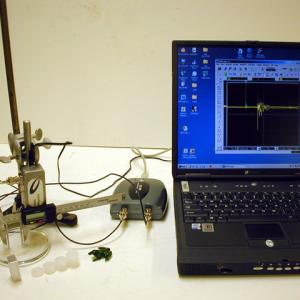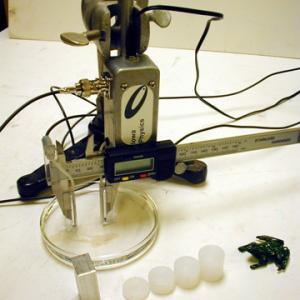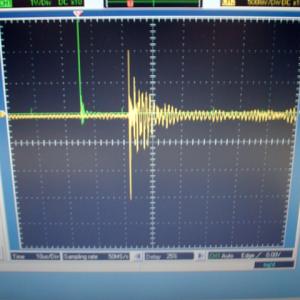College of Liberal Arts & Sciences
3B30.52 - Speed of Sound in Water / Ultrasonic
Connect the Soft Scope to the Caliper Apparatus. Lower the Calipers into a petri dish with 1/4 in. of water. Set the scope to the settings that are marked on the card in the Interface bag. If everything is running right, moving the calipers should show a real-time distance separation on the screen. This is the speed of sound in water.
Other rods of Plexiglas, aluminum, brass, or other metals may be placed between the jaws of the calipers. Essentially the measurement will be the speed of sound through any particular substance.
NOTE: This should still be done with the calipers immersed in the water. You will need the coupling that the water provides between the ultrasonic transducer and the object being measured for accurate measurements.
- Gustavo A. Mendes, Jusciane da Costa e Silva, Gustavo de O. G. Reboucas, "Instantaneous Measurement of the Speed of Sound in Air and Water Using Arduino", TPT, Vol. 61, #5, May 2023, p. 394.
- Sue Stocklmayer, John Rayner, Mike Gore, "Errata", TPT, Vol. 51, # 2, Feb. 2013, p. 72.
- Gorazd Planinsic, Eugenia Etkina, "Bubbles That Change the Speed of Sound", TPT, Vol. 50, Nov. 2012, p. 458.
- Tony Key, Robert Smidrovskis, Milton From, "Measuring the Speed of Sound in a Solid", TPT, Vol. 38, # 2, Feb. 2000, p. 76.
- Thomas B. Greenslade, Jr., "Experiments with Ultrasonic Transducers", TPT, Vol. 32, # 7, Oct. 1994, p. 392.
- A. A. Nash, "How Many Sics?", TPT, Vol. 15, # 8, Nov. 1977, p. 453.
- Thomas B. Greenslade, Jr., "19th Century Textbook Illustrations XI, The Speed of Sound in Water", TPT, Vol. 14, # 8, Nov. 1976, p. 510.
- Gorazd Planinsic, Eugenia Etkina, "Bubbles That Change the Speed of Sound", TPT, Vol. 50, Nov. 2012, p.458.
- Diego A. Luna, Mariano A. Real, and Debora V. Duran, "Undergraduate Experiment to Measure the Speed of Sound in Liquid by Diffraction of Light", AJP, Vol. 70, # 8, Aug. 2002, p.874.
- Gorazd Planinsic and Eugenia Etkina, Bubbles that Change the Speed of Sound, TPT, Vol. 50, # 8, Nov. 2012, p. 458.
- A. E. Lord Jr., "Simple Means of Generating Longitudinal Elastic Pulses in Liquids", AJP, Vol. 41, #3, March 1973, p. 433.
- S. B. Palmer, "Measurement of Velocity of Sound in Liquids", AJP, Vol. 39, #3, March 1971, p. 340.
- Richard J. Fitzgerald, "The Many Paths to Underwater Acoustic Communication", Physics Today, June 2015, p. 20.
- William A. Kuperman, James F. Lynch, "Shallow - Water Acoustics", Physics Today, Oct. 2004, p. 55.
Disclaimer: These demonstrations are provided only for illustrative use by persons affiliated with The University of Iowa and only under the direction of a trained instructor or physicist. The University of Iowa is not responsible for demonstrations performed by those using their own equipment or who choose to use this reference material for their own purpose. The demonstrations included here are within the public domain and can be found in materials contained in libraries, bookstores, and through electronic sources. Performing all or any portion of any of these demonstrations, with or without revisions not depicted here entails inherent risks. These risks include, without limitation, bodily injury (and possibly death), including risks to health that may be temporary or permanent and that may exacerbate a pre-existing medical condition; and property loss or damage. Anyone performing any part of these demonstrations, even with revisions, knowingly and voluntarily assumes all risks associated with them.


